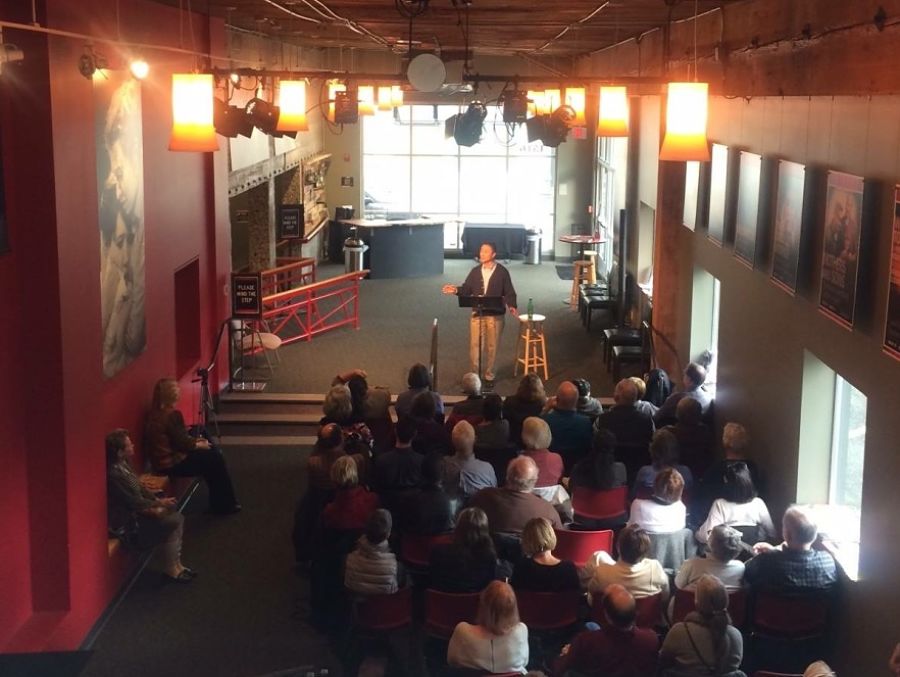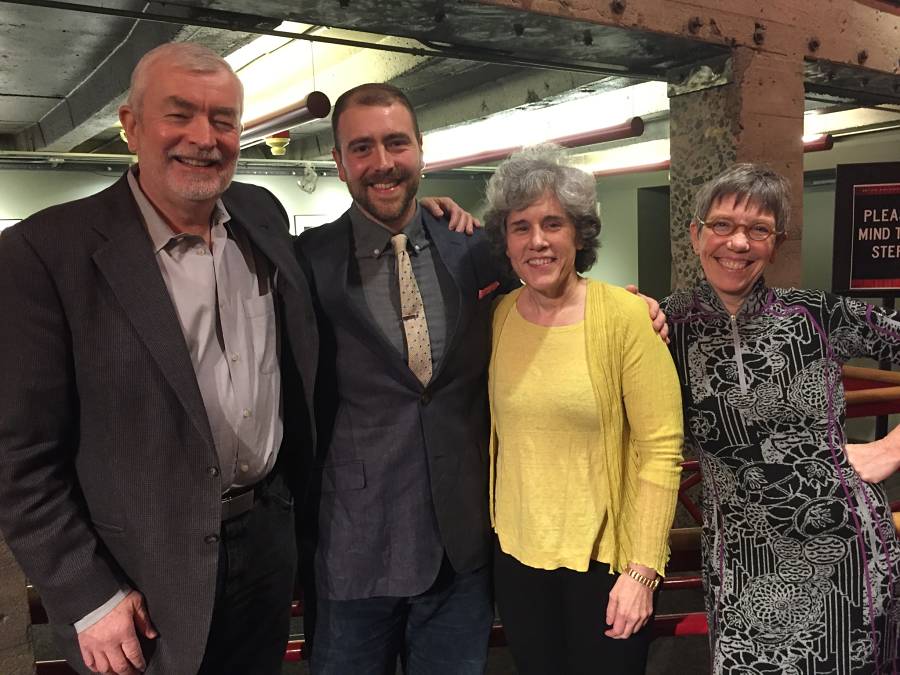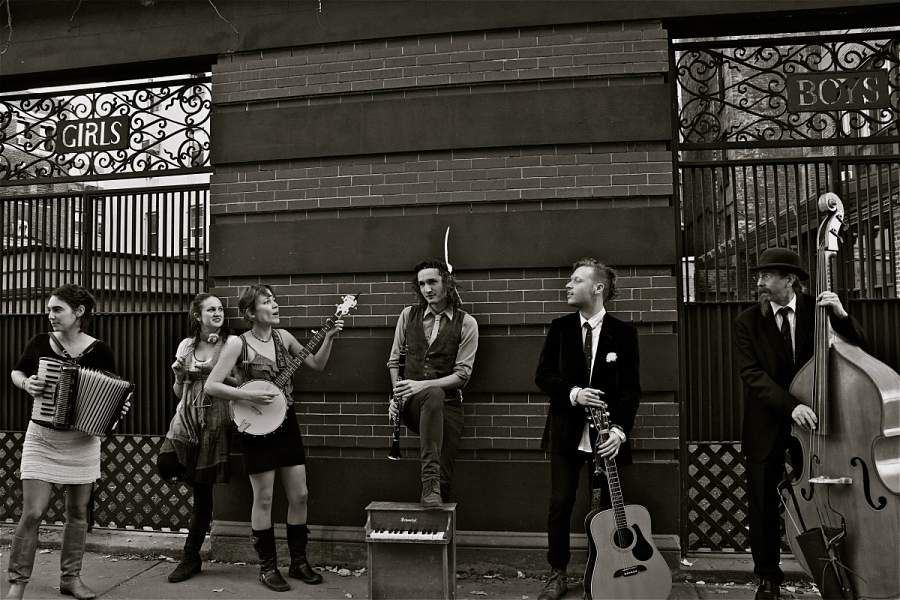PORTLAND, ORE.: Fertile Ground is the kind of festival where you can start your evening watching a reading of local playwright S. Renee Mitchell’s Ophelia in Oblivion, a chamber piece about an elderly woman cursing at ghosts in a church in North Portland, then drive 10 minutes into the city’s Eastside industrial district to a sliver of warehouse venue called the Steep and Thorny Way to Heaven for a genderqueer cabaret adaptation of Frankenstein.
From circus arts to one-person storytelling, Fertile Ground has something for everyone, the common threads being that all the theatre, dance, and animation included must be new work (world-premiere productions or new drafts for workshop/readings) and that it is primarily generated by Portland artists. (Full disclosure: My own theatre company hosted a panel discussion in this year’s festival, last year we had a festival show that won the local theatre award for Best Production, and I have been involved with the festival on and off since its inception. So, cards on the table, I’m hardly a disinterested party when it comes to Fertile Ground.)
Ground level at Fertile Ground, houses are packed with the fever of the festival-minded. While January rains down on the city, warm bodies in wet raincoats fog up lobby windows, and those without reservations are often out of luck. At an unbeatable $50, pass holders have access to an unlimited number of the 65-plus shows; reservations are essential at the small houses the festival thrives in.

Different-sized theatres use the festival to different ends: Individuals producing might test the waters with a few nights during the 11-day span (as with I Hate Positive Thinking, by Hand2mouth’s Faith Helma), while small to midsize companies program their seasons with the festival in mind so their runs overlap with it (I Want to Destroy You at Theatre Vertigo). Others use the festival as an excuse to gather a group of friends and test out an idea in front of a willing audience—seemingly the case with Matthew McConaughey vs. the Devil, music by Jonathan Quesenberry, which monopolized much of the city’s musical theatre talent for an evening and got raves from attendees on the event’s Facebook page. It’s a game where first-time producers, like new theatre company Source Material, can sell out a short run for a buzzy boost.
Other companies incorporate Fertile Ground into larger programming plans, such as [or, the whale], part of a trilogy of works that Portland Experimental Theatre Ensemble (PETE) began presenting in July 2015. The show, a poetic response to Herman Melville’s classic text, featured the crack ensemble in fine form playing in the deep of a dense yet whimsical text by playwright Juli Crockett. The play of language, meaning, and ideas is deeply rooted in the physical choices centering around the company’s ghostly, latex-painted lower limbs, representing Ahab’s ivory pegleg. Each of these multiple Ahabs’ creepily shiny “legs” came with a genius analog sound design to them (costumes by Jenny Ampersand).
Midway through the show language itself comes apart, giving way to pure sound and song as the performers and audience sit enshrouded in fog. The appearance of the final Ahab (Maureen Porter, on an absolute joy ride) blasts the play open like a tsunami through a blowhole.
Led by director and scenic designer Peter Ksander, the ship’s deck was a plywood platform floating within the black box theatre at Reed College, whose interior was completely covered in mylar. But the deus ex machina, of sorts, came in the last moments of the show, when a mirror-bespangled lower leg descended, a la disco ball, from the ceiling, channeling beams of light in all directions.
“We have to live up to the leg,” Ksander had vowed to himself during rehearsal. “Whatever we do.”
![A moment from "[or, the whale]" by Portland Experiemental Theatre Ensemble. (Photo by Jessica Wallenfels)](https://www.americantheatre.org/wp-content/uploads/or-the-whale_Portland-experimental-theatre-ensemble.jpg)
Though already a veteran playwright and author, S. Renee Mitchell began the script for Ophelia in Oblivion in a class at Portland Center Stage. In it, a dying African-American woman high on morphine (the moving Skeeter Greene), hurls racial slurs at her Latina hospice nurse (Jacque Dixon) to avoid the painful family secrets that keep her daughters away from her deathbed. Debates in purgatory that unlock the past ensue. Director Bobby Bermea shaped the story to get maximum impact from its final reversal, one that verged on the poetic-grotesque.
Frankenstein: A Cabaret brazenly mashed up theatrical conventions, juxtaposing interview theatre (confessional/testimonial voiceovers about desire) with a campy Captain emcee, a sexy trio of dancers and an everyperson Greek chorus commenting on the action. The Captain (the masterful Maggie Mascal, co-composer) was poured into a nautical blazer in a way that seemed to defy gravity; her counterpart was eight months pregnant and at one point wore nothing on top but pages from a book (this was co-composer/scriptwriter Laura Christina Dunn). Together, these two form Broken Planetarium.
At points the pair sat stage left speculating on Mary Shelley’s intentions and the absence of sexually empowered female images in contemporary culture. Mascal flirted with the audience mercilessly between local/topical references and appearances by nearly naked yet artfully bodypainted monsters in half-masks. The show’s songs were gripping and innovative, especially under the banner of cabaret, employing banjo, ukulele, theramin, concertina accordion, guitar, and cello. Out of the wacky/fantastic evening came a wounded monster played affectingly by Caitlin Nolan, who spoke of emotional violence and alluded to gender transition while the cast interrupted her with the refrain, “Sew me up.”
For the full-on theatre nerds, pre-show panel discussions dissected new works in two ways: with artists speaking about their current and future projects in 2016, presented by Risk/Reward, and Many Hats Collaboration’s “Growing new works within theatre institutions,” which featured literary manager/dramaturgs from major local and regional theatres.

Two generations of winners of the New Play Award from the Portland Civic Theatre Guild were represented in this year’s festival. In Steve Patterson’s Rimbaud’s Daughter in Louisiana (or the Drunken Pirogue, an offbeat female buddy comedy becomes a romance, then (maybe) a symbolist poem. Nancy Moss’ Deception took go-round #2 at Fertile Ground, having gotten a substantial rewrite when its white author received constructive feedback from her largely black cast last year. This year’s director, journalist/theatre artist Dmae Roberts, brought her own point of view to the concept of a multiracial person “passing” for white in 1880s Portland.
As a biracial Asian-American woman, Roberts explained how odd it is that, as she put it, “The only time I’ve ever played an Asian person onstage is as an understudy.” During the rehearsal process, she and lead actress Damaris Webb (also featured in Ophelia) asked each other, “Is it deception?”
The Fertile Ground Festival remains a democratic playground for all walks of performance, and an annual high-water mark for sheer quantity of civic hustle. It’s common to see performers in more than one production in the festival, perhaps in different capacities, and highly likely you’ll be running into the same audience members at multiple shows. In short, the city turns into a candy store for all the theatre-junkie kids. On this 11-day date performers and audiences can meet and fall in love, rekindle an old flame, or go on a pleasure spree, no matter their preference.
Jessica Wallenfels is a director/choreographer and educator, as well as artistic director of Many Hats Collaboration.


